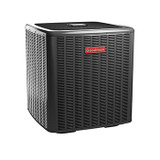HVAC 101: How Does Your HVAC Unit Work?
Heating, ventilation and air conditioning (HVAC) is a field that's remarkably complex due to the wide variety of different components that could be theoretically installed throughout someone's home or business. On the other hand, the basic concepts behind it are every bit as surprisingly simple. In order to heat a home up, some source of energy is used to raise temperatures. To cool them, fans are used to blow heat away while refrigerant gases are used to drop temperatures, much as they are when chilling foods.
As it turns out, it all starts with thermostats and sensors that make it possible for the system to know when it needs to switch on or off.
Starting & Stopping HVAC Systems
More than likely, the thermostat is the most obvious device attached to your HVAC system, since you interact with it. When the sensors connected it to find that the temperature in its surroundings are too far different from its setting, it sends an electrical signal to the furnace or air conditioner. A furnace uses some source of heat, whether an electrical resistor or gas flame, to raise the temperature of air. A blower motor then transports this newer warm air throughout your entire building.
When the air conditioner is used, refrigerant gases forced at high pressures through a small tube dramatically drop the temperature in the tube. A motor then sends air at this temperature throughout a house or building so that the air gets cooled down to a certain degree. Liquid from the air conditioner is pushed into a condenser, where it again turns into gas so that it can be compressed once again and therefore work to start the cycle all over.
In general, air conditioners actually use more energy since it's easier to generate heat than it ever is to abate it. Some zoned systems will allow you to cool down certain areas while keeping others at a higher temperature in order to reduce the overall amount of energy that your system uses.
Ventilation systems usually take the form of ducts that transport air. Vents allow it to freely enter into individual rooms. It's important that these ducts and vents don't get blocked over time because there's a risk that they can impede the flow of air, which in turn will make your HVAC equipment work much harder than it has to. Specialists will recommend that people get into a regular rhythm when it comes to their equipment in order to keep it running as efficiently as possible.
Servicing & Maintaining HVAC Technology
Eventually, many of these components will wear out and need to be replaced. Units are designed to be as modular as possible. The design ensures that each individual component could be swapped out if at all necessary.
For instance, air filters can easily be changed out in the future when it becomes necessary to do so. These are user-serviceable parts that can be swapped out with a bare minimum of tools. Dedicated technicians will use a maintenance checklist to inspect individual parts in order.
Improve Your Heating System With Furnace Part Source
We asked our crew here at Furnace Part Source to give a basic overview of how all of the pieces of gear attached to HVAC systems worked. Our team knows how to repair indoor and outdoor units.
Anybody who wants to learn more about HVAC technology can feel free to contact our team online for more information. Whether you want energy-efficient systems or temperature control, Furnace Part Source can help.
Recent Posts
-
Trane Central Air System Not Cooling
Struggling with a Trane central air system that won’t cool your home? You’re not alone. In this deta …27th Jun 2024 -
Lennox Central Air System Not Cooling
When your Lennox central air system stops cooling, it not only disrupts your comfort but can also si …27th Jun 2024 -
Goodman Central Air System Not Cooling
When your Goodman central air system is not cooling, it can be frustrating and uncomfortable, especi …20th Jun 2024




